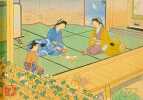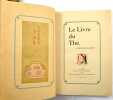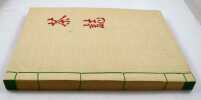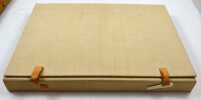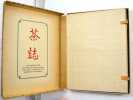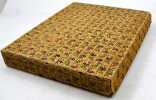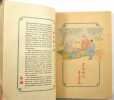OKAKURA-KAKUZO
Le Livre du thé
Paris, des presses de Léon Pichon, pour les Bibliophiles du Faubourg, 1930. 1 vol. in-8. Broché, cousu au fils vert à la manière japonaise,, couvertures de tissu crème, idéogrammes brodés en rouge, chemise à rabats avec lanières de cuir et attaches en nacre (manque une attache), emboîtage recouvert d'un tissu à motifs.
Reference : 11699
Traduction française par Gabriel Mourey, d'après l'édition originale parue en 1906 en Angleterre. Préface de Thomas Raucat.Ouvrage finement illustré de 15 aquarelles de J. A. Tohno reproduites par Saudé et présentation à la japonaise réalisée par Canape et Corriez.Tirage à 110 exemplaires, sur Impérial Annam à la cuve, celui-ci n°64, imprimé pour Louis Gouffé.Infimes rousseurs intérieures, effilochage et débuts de fentes aux mors de l'emboitage.
Bookseller's contact details
Librairie Gaëlle Cambon
Gaëlle Cambon
62 rue du Grand Marché
37000 Tours
France
librairiegaellecambon@gmail.com
06 87 38 21 05
Payment mode

Sale conditions
Sur Rendez-vous! Conditions de vente conformes aux usages de la librairie ancienne et moderne. Les prix sont nets, frais de port à la charge de l’acheteur. Les envois sont toujours effectués avec suivi. Les règlements peuvent être effectués par chèque (les chèques sur les banques étrangères doivent être majorés de 20 €), paypal ou virement bancaire.
5 book(s) with the same title
Le Livre du thé.
P., Flammarion, [1993], in-4, cart. toilé noir et jaquette éd., gardes ill., carte, glossaire, bibliographie, index. (DM90)
De la plantation à la tasse, de la préparation du thé au choix du cru à déguster en fonction du moment de la journée.Préface par Anthony Burgess.
Le dernier ennemi. Traduit du livre anglais "The last Ennemy" par R. Jouan. Avant-propos de l'Amiral Jubelin.
1953 Paris, France-Empire, 1953, in 8° broché, 301 pages ; illustrations hors-texte ; jaquette illustrée en couleurs (infimes défauts).
...................... Photos sur demande ..........................


Phone number : 04 77 32 63 69
Le livre du Thé. Nouvelle édition ornée de 2 hors-texte.
Lyon, Derain, 1958, in 12 carré, 124 pages, couverture rempliée.
PHOTOS sur DEMANDE. ...................... Photos sur demande ..........................


Phone number : 04 77 32 63 69
Le livre-joujou. - [THE INVENTION OF THE PULLABLE PART]
Paris (Imprimerie de Ducessios), Louis Janet (Vve Magnin & Fils), (1875?). Small 8vo (binding: 14,8 x 11,2 cm.). Original full red cloth with gilt title to front board. All edges gilt. Very neatly rebacked. A splendid copy, with only minor occasional, light brownspotting and nice and bright text-leaves. One leaf of text (pp. 115-16) has had the lower corner torn off, so a part of that text-leaf is missing. Plates are in splendid condition - nice, clean, and crisp -, and all moveable parts present, fully intact and fully workable. XV (including the handcoloured title-page with moveable parts), (1), (137) pp. + 12 magnificent plates in wonderful original hand-colouring and with moveable parts.
Incredibly scarce third issue (with the original plates and moveable parts of the first issue) of one of the most important and rarest children's books ever produced, namely the first printed book with pullable parts, sometimes called ""the first interactive book"". In all, three issues of the work appeared. All three are of the utmost scarcity, as only 20 copies (apart from the present) in all, from either of the three issues are known. And of these 20 copies, at least five are incomplete. Of the three issues, the third is the scarcest, as only two or three other copies apart from the present are known. Two of these are in institutional holdings, and a third, which is possibly the third issue, is in a private collection in Japan. The first issue of the work is thought to have appeared in 1831 and the second around 1837. The three issues are quite easily distinguishable, although some variants appear. The first issue was printed by Doyen, and the second and third by Ducessois. Magnin, the successor of Janet, adopts the name ""Veuve Magnin et Fils"" in 1867, and the copies that bear this imprint on the title-page thus belong to the third issue. Saint-Alban argues that it was printed in 1875. But the setting seems to be exactly the same as the preceding issue (which has the preliminary leaves reset in comparison to the first issue), and the plates and moveable parts are certainly those of the first issue. Possibly, only the first three leaves (half-title and title-pages) are actually in a new printing, with new publisher and printer, and the rest are the same as the second issue. And possibly, only the 15 first pages differ from the first issue, so that the rest is actually the same printing throughout all the issues. In the introduction to this wonderful book, the author explains to his young readers - whom he addresses directly - that he has invented the present ""mechanism"" in order to rediscover the magic of the metamorphoses caused by the fairy wands and ""to bring into action"" the scenes from the history"". The book is truly splendid, in both beauty, detail, and innovation. Brès is known as the creator of some of the most beautiful children's books ever produced, accompanied, by wonderful coloured engravings. In the present work, he excelled completely and introduced an entirely new way of creating children's books, which was far ahead of its time. In fact, the kind of interactive book that Brès here introduces, pioneered the interactive books that were to appear in the 1930'ies.
Le Livre du Thé.
<meta charset="utf-8"><div class="fp-wide--block fp-wide--block-resume" id="resume" data-mce-fragment="1"><div class="content" data-mce-fragment="1">Okakura rédigea Le Livre du thé en 1906 en anglais afin de transmettre aux Occidentaux l'atmosphère et l'esprit mêmes de la cérémonie du thé (cha no y) et de la voie du thé (chado), considérée comme un mode de vie à part entière. Pour souligner la dimension religieuse de la voie du thé, Okakura parle aussi de "théisme" et de "culte du thé" - sa vision s'enracinant dans les valeurs religieuses du bouddhisme, du taoïsme et du confucianisme.<br data-mce-fragment="1">Une petite chose, comme boire une tasse de thé, obéit ainsi à un rituel précis et devient une intense communion spirituelle, en même temps qu'une expérience esthétique : l'écoute de la voie intérieure est enchevêtrée de peinture et de calligraphie, de poésie, de philosophie, d'art céramique et d'art floral. En 1930, les Bibliophiles du Faubourg publièrent Le Livre du thé dans une admirable édition comprenant la traduction du critique d'art et poète Gabriel Mourey (1865-1943), une préface de Thomas Raucat et des aquarelles de J.<br data-mce-fragment="1">A. Tohno. Cet ouvrage est le fac- similé de l'exemplaire n° 94 imprimé pour M. Henri Ullmann.</div></div><div class="fp-wide--block fp-wide--block-specification" id="specification" data-mce-fragment="1"><div class="fp-wide--block--header" data-mce-fragment="1"></div></div> Paris, 2023 Citadelles & Mazenod 152 p., illustré, emboîtage cartonné. 20 x 26,6
Neuf
 Write to the booksellers
Write to the booksellers
